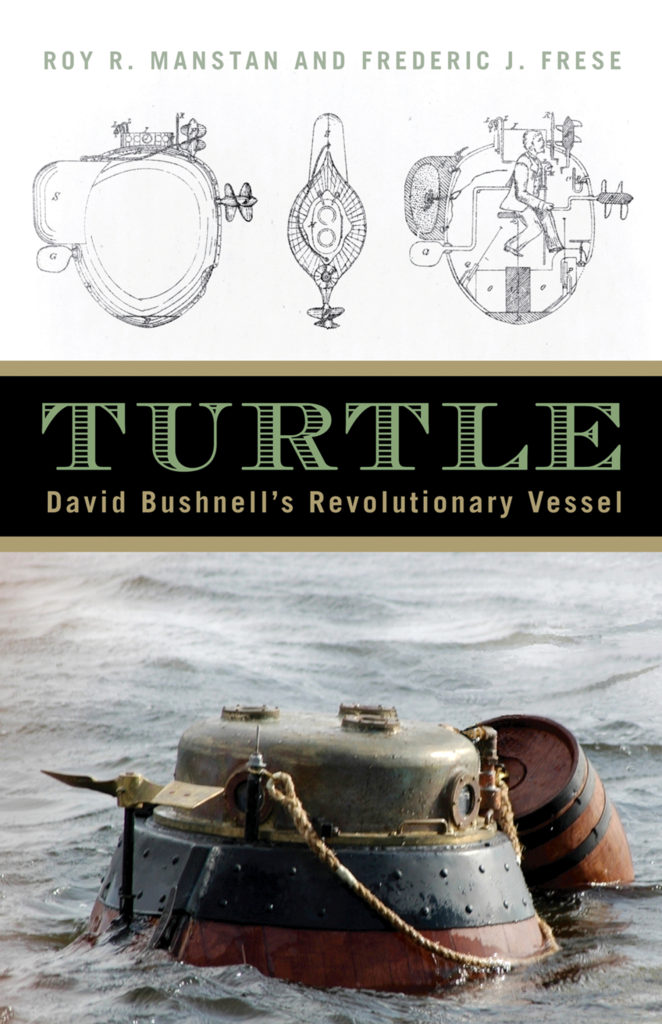

Turtle
David Bushnell's Revolutionary Vessel
$34.95 Add to Cart Save 25% on every book by joining our Book Club


The Remarkable History and Reconstruction of the First Operational Submarine
At the onset of the American Revolution, the British expected to quell the rebellion quickly with a show of overwhelming force. In an experiment in asymmetric warfare, David Bushnell created the first submarine vessel designed specifically “for the destruction of vessels of war.” On a quiet September night in 1776, sergeant Ezra Lee maneuvered Bushnell’s strange little craft out from Manhattan and into the midst of the greatest naval fleet ever assembled in the Americas. Lee’s goal was to sink the British flagship HMS Eagle by attaching a powerful explosive to its hull. Although the mission was unsuccessful, Bushnell’s concept of submarine warfare was considered by George Washington to have been “an effort of genius.”
David Bushnell was raised in the town of Saybrook at the mouth of the Connecticut River. More than two centuries later, another Turtle would be launched into the same river within sight of Bushnell’s first forays with his vessel during the summer of 1775. Under the direction of technical arts teacher Frederic J. Frese, students at Old Saybrook High School created a working replica of Bushnell’s submarine, facilitated through an education partnership with the Naval Undersea Warfare Center in Newport, Rhode Island, where Roy R. Manstan was a mechanical engineer and Navy trained diver. With twenty-first century submariners at the helm, the Turtle replica was subjected to a series of operational tests at the Mystic Seaport Museum in Mystic, Connecticut.
In Turtle: David Bushnell’s Revolutionary Vessel, the authors provide new insight into Bushnell’s “engine of devastation,” tracing the history of undersea warfare before Bushnell and the origin of the many innovations Bushnell understood would be necessary for conducting a covert submarine attack. The knowledge gained from testing the Turtle replica enabled the authors to speculate as to what America’s first submariner Ezra Lee experienced that September night and what may have caused the attack to fail.

Roy R. Manstan is a mechanical engineer and former Command Diving Officer of the NUWC. He has degrees from Lafayette College, the University of Connecticut, and Connecticut College.
Frederic J. Frese is a technical arts teacher at Old Saybrook High School. He received his teaching degree from Central Connecticut State University.
“Excellent. . . . A valuable contribution.” —Nautical Research
“Highly recommended.” —Choice
“This fascinating and detailed book covers both the history of the original craft and a report on the construction and operation of the replica.” —Work Boat World (Australia)
“An unusual maritime history book that is both engrossing and a pleasure to read.” —Northern Mariner
“Thanks to the authors of this well-executed history, we have a much better idea of how [the Turtle and its mission] worked out.” —International Journal of Maritime History
“Built at the dawn of the American Revolution, the one-man wooden submersible, its creation, and its attacks on the Royal Navy in New York harbor is a story still surrounded in mystery. In this much anticipated book, Roy Manstan and Frederic Frese bring the story of Bushnell’s revolutionary underwater machine to life.”—Jerry Roberts, Connecticut River Museum